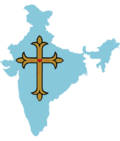| St. George Syro-Malabar Catholic Basilica | |
|---|---|
 Current structure | |
 | |
| 10°11′26″N76°22′58″E / 10.1906°N 76.3828°E | |
| Location | Angamaly, Kerala |
| Country | India |
| Denomination | Syro-Malabar Church |
| Membership | 3331 families |
| Website | www |
| History | |
| Former name(s) | Angamaly Valiyapalli [1] |
| Status | minor basilica |
| Dedication | St. George |
| Dedicated | New church blessed on 31 December 2006 |
| Earlier dedication | St. Mary, Mother of Light and Life [2] |
| Consecrated | 450 |
| Architecture | |
| Functional status | Usual |
| Demolished | ancient church demolished in 2006 |
| Specifications | |
| Floor area | 24000 sq. ft. |
| Administration | |
| District | Ernakulam |
| Presbytery | Jimmy Poochakkattu |
| Archdiocese | Ernakulam-Angamaly |
| Clergy | |
| Archbishop | Raphael Thattil |
| Rector | Jimmy Poochakkattu |
| Vicar(s) | Jimmy Poochakkattu |
St. George Syro-Malabar Catholic Basilica is a basilica of the Syro-Malabar Catholic Church situated in Angamaly, Kerala, India. On 24 June 2009, Pope Benedict XVI raised St George Forane Church to the status of minor basilica. Together with an underground parish hall where wedding gatherings are commonly held, it covers about 24,000 sq ft (2,200 m2). [3]

